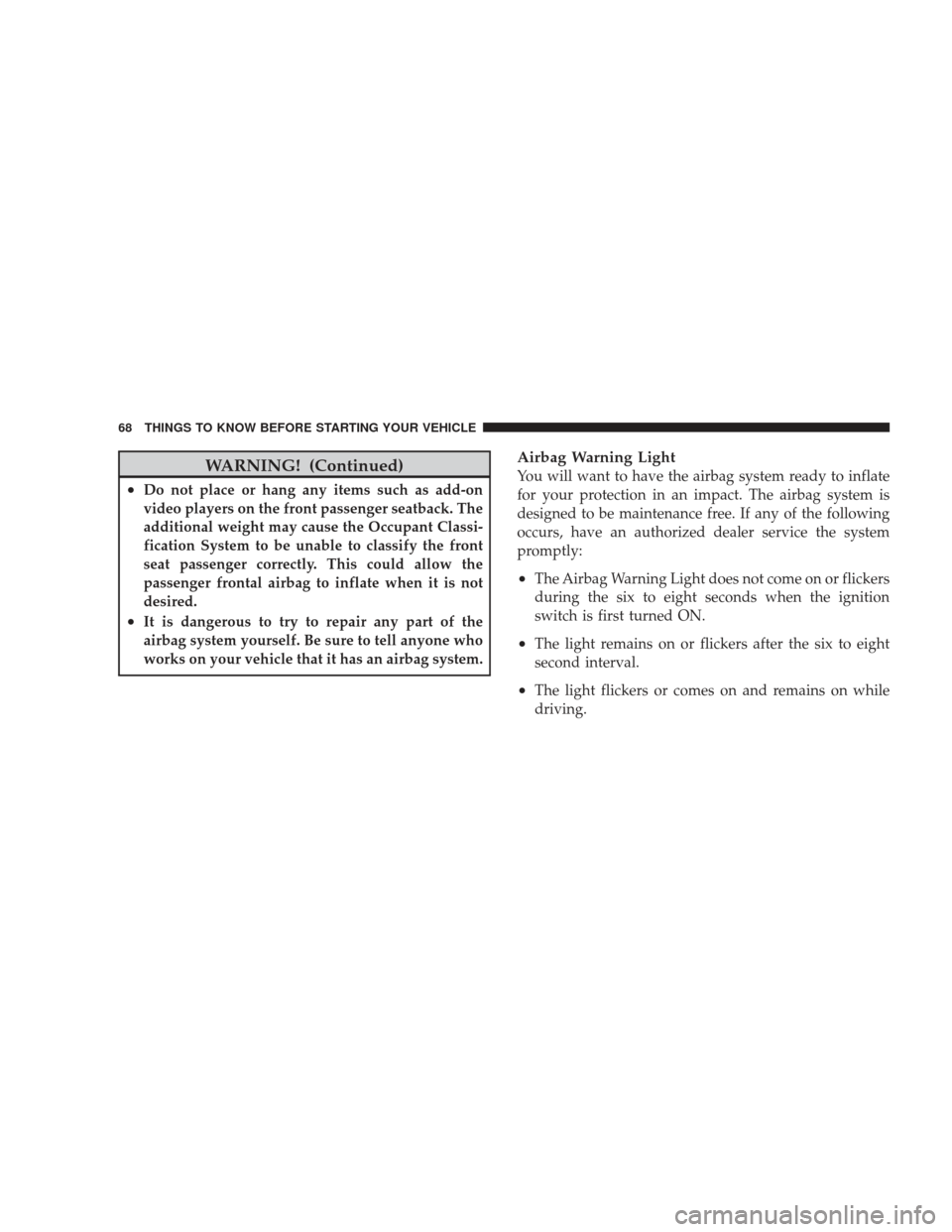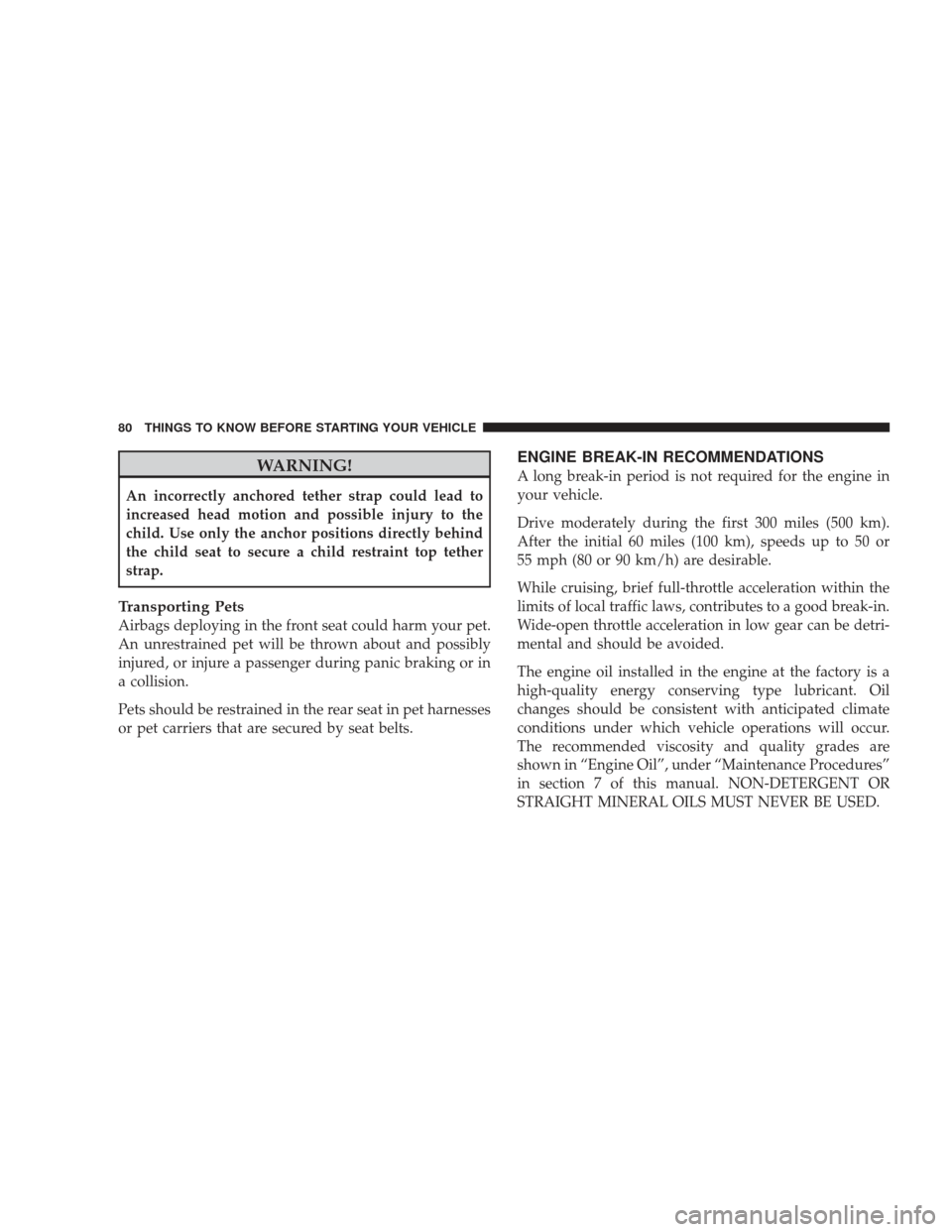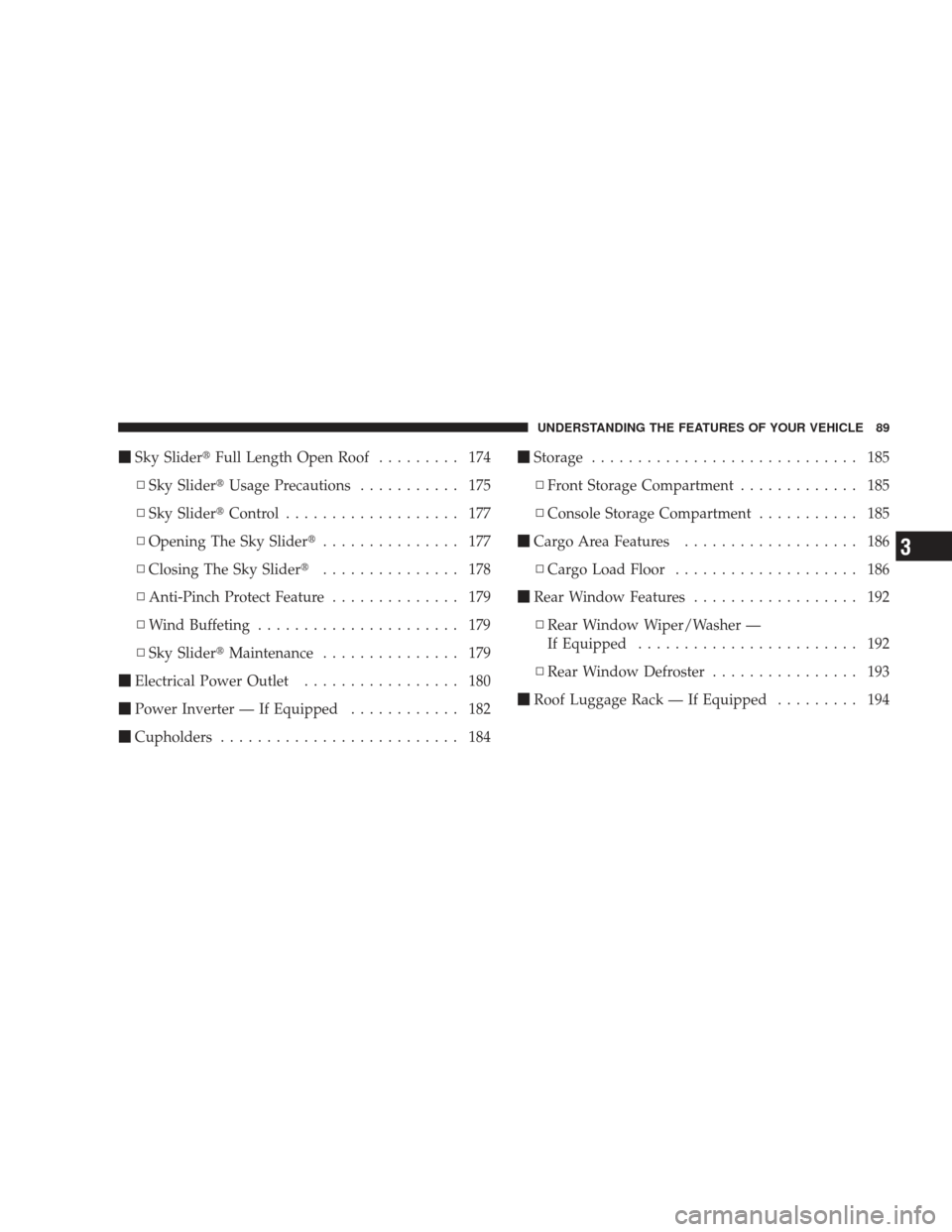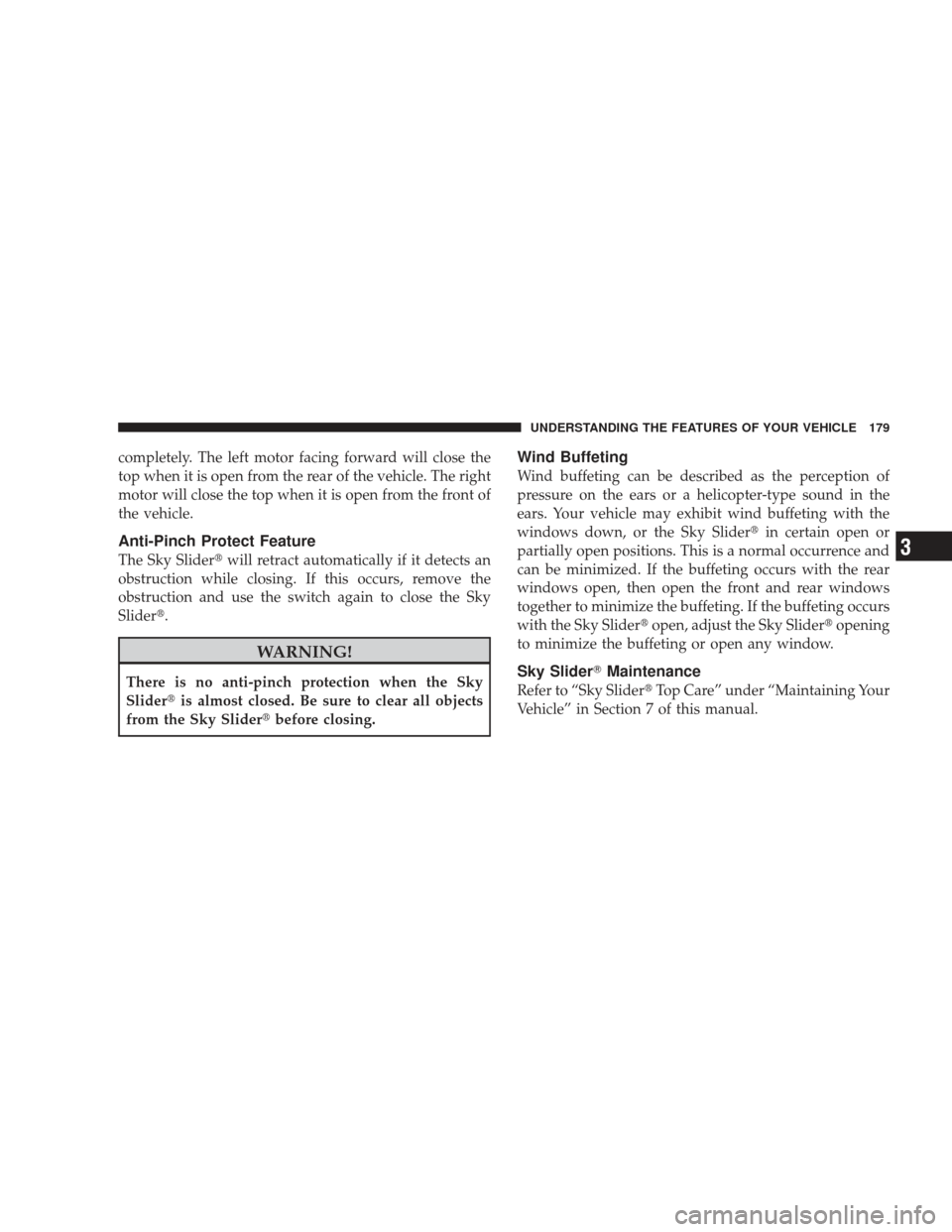Page 3 of 506
TABLE OF CONTENTSSECTIONPAGE
1INTRODUCTION.............................................................3
2THINGS TO KNOW BEFORE STARTING YOUR VEHICLE...............................9
3UNDERSTANDING THE FEATURES OF YOUR VEHICLE...............................85
4UNDERSTANDING YOUR INSTRUMENT PANEL................................... 197
5STARTING AND OPERATING................................................. 287
6WHAT TO DO IN EMERGENCIES...............................................393
7MAINTAINING YOUR VEHICLE............................................... 407
8MAINTENANCE SCHEDULES.................................................. 453
9IF YOU NEED CONSUMER ASSISTANCE..........................................469
10INDEX....................................................................479
1
2
3
4
5
6
7
8
9
10
Page 6 of 506

INTRODUCTION
This Owner’s Manual has been prepared with the assis-
tance of service and engineering specialists to acquaint
you with the operation and maintenance of your vehicle.
It is supplemented by a Warranty Information Booklet
and various customer-oriented documents. You are
urged to read these publications carefully. Following the
instructions and recommendations in this manual will
help assure safe and enjoyable operation of your vehicle.
NOTE: After you read the manual, it should be stored
in the vehicle for convenient referencing and remain
with the vehicle when sold, so that the new owner will
be aware of all safety warnings.
When it comes to service, remember that your authorized
dealer knows your vehicle best, has the factory-trained
technicians and genuine Mopar�parts, and is interested
in your satisfaction.
ROLLOVER WARNING
Utility vehicles have a significantly higher rollover rate
than other types of vehicles. This vehicle has a higher
ground clearance and a higher center of gravity than
many passenger cars. It is capable of performing better in
a wide variety of off-road applications. Driven in an
unsafe manner, all vehicles can go out of control. Because
of the higher center of gravity, if this vehicle is out of
control it may roll over when some other vehicles may
not.
Do not attempt sharp turns, abrupt maneuvers, or other
unsafe driving actions that can cause loss of vehicle
control. Failure to operate this vehicle safely may result
in an accident, rollover of the vehicle, and severe or fatal
injury. Drive carefully.
4 INTRODUCTION
Page 70 of 506

WARNING! (Continued)
•Do not place or hang any items such as add-on
video players on the front passenger seatback. The
additional weight may cause the Occupant Classi-
fication System to be unable to classify the front
seat passenger correctly. This could allow the
passenger frontal airbag to inflate when it is not
desired.
•It is dangerous to try to repair any part of the
airbag system yourself. Be sure to tell anyone who
works on your vehicle that it has an airbag system.
Airbag Warning Light
You will want to have the airbag system ready to inflate
for your protection in an impact. The airbag system is
designed to be maintenance free. If any of the following
occurs, have an authorized dealer service the system
promptly:
•The Airbag Warning Light does not come on or flickers
during the six to eight seconds when the ignition
switch is first turned ON.
•The light remains on or flickers after the six to eight
second interval.
•The light flickers or comes on and remains on while
driving.
68 THINGS TO KNOW BEFORE STARTING YOUR VEHICLE
Page 82 of 506

WARNING!
An incorrectly anchored tether strap could lead to
increased head motion and possible injury to the
child. Use only the anchor positions directly behind
the child seat to secure a child restraint top tether
strap.
Transporting Pets
Airbags deploying in the front seat could harm your pet.
An unrestrained pet will be thrown about and possibly
injured, or injure a passenger during panic braking or in
a collision.
Pets should be restrained in the rear seat in pet harnesses
or pet carriers that are secured by seat belts.
ENGINE BREAK-IN RECOMMENDATIONS
A long break-in period is not required for the engine in
your vehicle.
Drive moderately during the first 300 miles (500 km).
After the initial 60 miles (100 km), speeds up to 50 or
55 mph (80 or 90 km/h) are desirable.
While cruising, brief full-throttle acceleration within the
limits of local traffic laws, contributes to a good break-in.
Wide-open throttle acceleration in low gear can be detri-
mental and should be avoided.
The engine oil installed in the engine at the factory is a
high-quality energy conserving type lubricant. Oil
changes should be consistent with anticipated climate
conditions under which vehicle operations will occur.
The recommended viscosity and quality grades are
shown in “Engine Oil”, under “Maintenance Procedures”
in section 7 of this manual. NON-DETERGENT OR
STRAIGHT MINERAL OILS MUST NEVER BE USED.
80 THINGS TO KNOW BEFORE STARTING YOUR VEHICLE
Page 90 of 506

�Rear Park Assist System — If Equipped ...... 158
▫ System Usage Precautions .............. 159
▫ Enabling And Disabling The System ....... 161
▫ System Operation .................... 162
� Garage Door Opener — If Equipped ........ 165
▫ Programming HomeLink� .............. 166
▫ Gate Operator/Canadian Programming .... 169
▫ Using HomeLink� ................... 169
▫ Reprogramming A Single
HomeLink� Button................... 170
▫ Security ........................... 170
▫ Troubleshooting Tips .................. 170
▫ General Information .................. 171 �
Power Sunroof — If Equipped ............ 171
▫ Opening Sunroof — Express ............ 172
▫ Opening Sunroof — Manual Mode ........ 172
▫ Closing Sunroof — Express ............. 172
▫ Closing Sunroof — Manual Mode ........ 173
▫ Pinch Protect Feature ................. 173
▫ Pinch Protect Override ................ 173
▫ Venting Sunroof — Express ............. 173
▫ Sunshade Operation .................. 173
▫ Wind Buffeting ...................... 174
▫ Sunroof Maintenance ................. 174
▫ Ignition Off Operation ................. 174
88 UNDERSTANDING THE FEATURES OF YOUR VEHICLE
Page 91 of 506

�Sky Slider� Full Length Open Roof ......... 174
▫ Sky Slider� Usage Precautions ........... 175
▫ Sky Slider� Control................... 177
▫ Opening The Sky Slider� ............... 177
▫ Closing The Sky Slider� ............... 178
▫ Anti-Pinch Protect Feature .............. 179
▫ Wind Buffeting ...................... 179
▫ Sky Slider� Maintenance ............... 179
� Electrical Power Outlet ................. 180
� Power Inverter — If Equipped ............ 182
� Cupholders .......................... 184 �
Storage ............................. 185
▫ Front Storage Compartment ............. 185
▫ Console Storage Compartment ........... 185
� Cargo Area Features ................... 186
▫ Cargo Load Floor .................... 186
� Rear Window Features .................. 192
▫ Rear Window Wiper/Washer —
If Equipped ........................ 192
▫ Rear Window Defroster ................ 193
� Roof Luggage Rack — If Equipped ......... 194
UNDERSTANDING THE FEATURES OF YOUR VEHICLE 89
3
Page 176 of 506

Wind Buffeting
Wind buffeting can be described as the perception of
pressure on the ears or a helicopter-type sound in the
ears. Your vehicle may exhibit wind buffeting with the
windows down, or the sunroof (if equipped) in certain
open or partially open positions. This is a normal occur-
rence and can be minimized. If the buffeting occurs with
the rear windows open, then open the front and rear
windows together to minimize the buffeting. If the
buffeting occurs with the sunroof open, adjust the sun-
roof opening to minimize the buffeting or open any
window.
Sunroof Maintenance
Use only a non-abrasive cleaner and a soft cloth to clean
the glass panel.
Ignition Off Operation
For vehicles not equipped with the Electronic Vehicle
Information Center (EVIC), the power sunroof switchwill remain active for 45 seconds after the ignition switch
is turned to the LOCK position. Opening either front
door will cancel this feature.
For vehicles equipped with the EVIC, the power sunroof
switch will remain active for up to approximately ten
minutes after the ignition switch is turned to the LOCK
position. Opening either front door will cancel this
feature. The time is programmable. For details, refer to
“Delay Power Off to Accessories Until Exit,” under
“Personal Settings (Customer-Programmable Features)”
under “Electronic Vehicle Information Center (EVIC)” in
Section 4 of this manual.
SKY SLIDER�
FULL LENGTH OPEN ROOF
The Sky Slider� is a full-length, soft-top, power roof that
opens front to rear or rear to front.
174 UNDERSTANDING THE FEATURES OF YOUR VEHICLE
Page 181 of 506

completely. The left motor facing forward will close the
top when it is open from the rear of the vehicle. The right
motor will close the top when it is open from the front of
the vehicle.
Anti-Pinch Protect Feature
The Sky Slider�will retract automatically if it detects an
obstruction while closing. If this occurs, remove the
obstruction and use the switch again to close the Sky
Slider�.
WARNING!
There is no anti-pinch protection when the Sky
Slider� is almost closed. Be sure to clear all objects
from the Sky Slider� before closing.
Wind Buffeting
Wind buffeting can be described as the perception of
pressure on the ears or a helicopter-type sound in the
ears. Your vehicle may exhibit wind buffeting with the
windows down, or the Sky Slider� in certain open or
partially open positions. This is a normal occurrence and
can be minimized. If the buffeting occurs with the rear
windows open, then open the front and rear windows
together to minimize the buffeting. If the buffeting occurs
with the Sky Slider� open, adjust the Sky Slider� opening
to minimize the buffeting or open any window.
Sky Slider� Maintenance
Refer to “Sky Slider� Top Care” under “Maintaining Your
Vehicle” in Section 7 of this manual.
UNDERSTANDING THE FEATURES OF YOUR VEHICLE 179
3